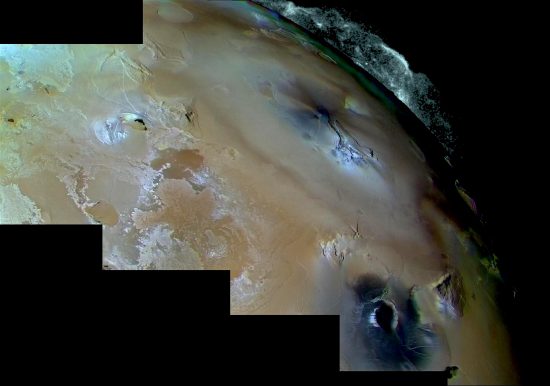Jan 26, 2016
Does tectonic activity form the mountains on Io over eons of time?
South Boösaule Montes is approximately 18 kilometers high and covers 17,900 square kilometers, making it one of the tallest mountains in the Solar System. It happens to be located on Jupiter’s moon, Io. How did the more than 135 identified mountains form on Jupiter’s frigid moon? Despite the fact that previously molten sulfur covers Io, and that there are so-called “volcanic plumes” visible from space, the average surface temperature is -135 Celsius.
Io is Jupiter’s third largest moon. However, its diameter of 3636 kilometers means that it is tiny when compared to its gigantic parent (142,984 kilometers at the equator), so Jupiter exerts a strong influence that, depending on the viewpoint, takes the form of gravity or electromagnetism.
According to a recent press release, tidal strain from Jupiter, which causes eruptions of magma, builds up deep deposits that compress the moon’s interior, increasing with depth. This causes uneven forces that lead to fracturing. Once fractures occur, the surface buckles, folds and cracks, pushing Io’s mountains up from below.
The conventional view sees Io in the grip of Jupiter’s gravity; flexing and twisting because that force is not equally applied. Since there are different gravitational gradients inside Io, it is “kneaded” by Jupiter, causing friction that is thought to heat the moon. Picture of the Day articles, on the other hand, discuss several confirmed predictions about electrical activity on Io. There is intense electric arcing between the moon and Jupiter.
Io is in close orbit with Jupiter, so intense electromagnetic radiation bombards its surface, removing approximately one ton per second in gases and other materials. Io acts like a generator as it travels through Jupiter’s plasmasphere. More than four hundred thousand volts at three million amperes of current flows into the electric environment of Jupiter from Io.
In 2008 JPL announced that Jupiter’s rings are electrically charged. More than eight years ago the Picture of the Day wrote that Io’s volcanoes are where plasma discharges connect the moon to the gas giant. All four of Jupiter’s largest moons leave their marks in its aurora, proving their charge flow to the planet. Those marks take the shape of “tails” within the auroral plasma column. The New Horizons mission that recently flew by the dwarf planet, Pluto, saw the “plumes” of Tvashtar, a gigantic volcano on Io, were filamentary in structure, indicating that they are corona arc discharges from electric hot spots that link Io with Jupiter.
When gas giant planets experience episodes of increased electrical activity for any reason, they might expel more compressed lumps of matter that are created by Birkeland current filaments undergoing z-pinch constrictions. Those lumps are what became the rocky planets and moons. Electrical interactions tend to transfer energy in a relatively short time, so interactions among those bodies are minimized, resulting in an orbital distribution that appears to have been stable for eons. Many anomalies that are seen when observing the Solar System are explained by the electrical theory, without the theory having to be adjusted case-by-case as in the gravity model.
Io was positively charged with respect to the new environment outside Jupiter, so it experienced intense electrical activity after it was ejected. Electric arcs raised anode blisters, called fulgamites. Close inspection of the structures on Io will most likely find that they have more in common with fulgamites than with tectonic activity caused by volcanoes.
Stephen Smith













